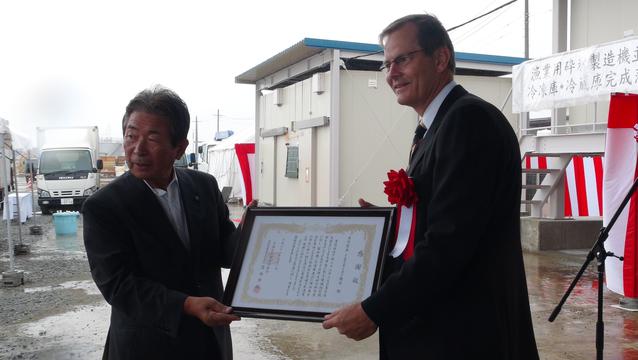Difference between revisions of "Template:Humanitarian Aid Updates"
| Line 1: | Line 1: | ||
'''LDS Church Continues Aid to Japan''' | '''LDS Church Continues Aid to Japan''' | ||
| − | [[Image:ldschurchJapan.jpg|alt=Mormon aid to Japan|left | + | [[Image:ldschurchJapan.jpg|250px|thumb|alt=Mormon aid to Japan|left]] |
[[The Church of Jesus Christ of Latter-day Saints]] has a world-recognized pattern for quickly providing emergency response in cases of disaster. Latter-day Saints do not choose congregations to attend, but are assigned to "wards" organized geographically. A system of leadership organized among its lay clergy enables fast communication from the bottom up ([[Home Teaching]], [[Visiting Teaching]]) and the top down. The Mormon leadership in Northeastern Japan worked tirelessly after the 9.0 earthquake of March, 2011, to account for missionaries serving in the area, members, and facilities of the Church, and then to assess needs of all citizens and decide how to quickly get aid in to stricken areas. | [[The Church of Jesus Christ of Latter-day Saints]] has a world-recognized pattern for quickly providing emergency response in cases of disaster. Latter-day Saints do not choose congregations to attend, but are assigned to "wards" organized geographically. A system of leadership organized among its lay clergy enables fast communication from the bottom up ([[Home Teaching]], [[Visiting Teaching]]) and the top down. The Mormon leadership in Northeastern Japan worked tirelessly after the 9.0 earthquake of March, 2011, to account for missionaries serving in the area, members, and facilities of the Church, and then to assess needs of all citizens and decide how to quickly get aid in to stricken areas. | ||
Revision as of 12:04, 27 September 2011
LDS Church Continues Aid to Japan
The Church of Jesus Christ of Latter-day Saints has a world-recognized pattern for quickly providing emergency response in cases of disaster. Latter-day Saints do not choose congregations to attend, but are assigned to "wards" organized geographically. A system of leadership organized among its lay clergy enables fast communication from the bottom up (Home Teaching, Visiting Teaching) and the top down. The Mormon leadership in Northeastern Japan worked tirelessly after the 9.0 earthquake of March, 2011, to account for missionaries serving in the area, members, and facilities of the Church, and then to assess needs of all citizens and decide how to quickly get aid in to stricken areas.
The LDS Church is often the last to leave devastated areas. Help is still being provided to victims of the 2004 tsunami that took the lives of over 200,000 people in southeast Asia. In like fashion, LDS still continues to give aid in Japan. Two recent efforts include the donation of a new industrial size ice maker to fishermen in a small village near Sendai, and the restoration of a Shinto shrine in Tagajo.
The 11 March 2011 tsunami destroyed all but one of 84 fishing boats in a local fishing cooperative near Sendai. Although some boats have been prepared, there has been no access to ice to preserve the fish after they are caught. Now the local fishermen are able to go back to work and support their families. A Mormon missionary from Alpine, Utah, Elder Masahisa Watabe, discovered the need. Elder Watabe is serving as a senior missionary along with his wife. He was born and raised in Sendai, but had not returned for many years. When he returned to help rebuild, he met a prominent friend in the community and learned about the fishermen. The gift was announced on June 15th by the Presiding Bishop of the LDS Church, H. David Burton. The ribbon-cutting ceremony for the huge ice maker, a cold-storage unit and three refrigerated trucks took place on September 1, 2011.
- "The ice machine is capable of making 3.3 tons of ice a day. Prefectural Fishing Cooperative President Shinetsu Kikuchi called the gift “a large step for people in the fishing industry” as he presented a plaque of appreciation to the Church." [1]
Also near Sendai is a terribly damaged Shinto shrine, which was recently restored by eighty Mormon missionaries. The shrine is the Yawata Shrine in Tagajo, just outside Sendai. Missionaries from the Church’s Tokyo mission rode a bus all night to spend the next day clearing out debris and salvaging the shrine’s treasures. The Yawata Shrine is hundreds of years old and is designated as a Historical Legacy Site in Japan.
The March tsunami washed over the shrine, flooding it, and washed cars into the grounds and scattered and destroyed sacred artifacts. Priests at Meiji Shrine in Tokyo invited LDS Church leaders to describe how the Church conducts its humanitarian efforts around the world. The presentation was made to 50 Meiji priests and employees. It was organized by Moriyasu Ito, a Meiji priest who studied at Brigham Young University.
- Representatives of the LDS Church "explained the Church’s global relief efforts and the extensive contributions made in Japan, which include large cash donations, supplies of gasoline, food, water, blankets, clothing, hygiene kits and large pieces of equipment, such as the aforementioned ice-making and storage facilities for fishermen. The Church has sent more than 18,000 volunteers who have given approximately 160,000 hours of service in the disaster zone."
Donations for LDS Church relief efforts can be made at LDS Emergency Response.
